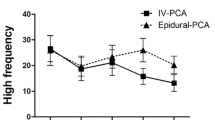Abstract
Since repeated noxious stimuli may sensitize neuropathic pain receptors of the spinal cord, we tested the hypothesis that the appropriate blockade of surgical stimuli with epidural anesthesia during upper abdominal surgery would be beneficial for postoperative analgesia. Thirty-six adult patients undergoing either elective gastrectomy or open cholecystectomy were randomly allocated to receive either inhalational general anesthesia alone (group G) or epidural anesthesia along with light general anesthesia (group E) throughout the surgery. Postoperative pain management consisted of patient-controlled analgesia (PCA) with bupivacaine accompanied by the continuous infusion of buprenorphine. To assess postoperative pain, a visual analogue scale (VAS) was employed at 2, 24, and 48 h postoperatively. While there was no significant difference in the bupivacaine dose, more patients undergoing gastrectomy in group G required supplemental analgesics than those in group E, and the VAS scores in group E demonstrated significantly better postoperative analgesia compared to group G after both types of surgery. Thus, an appropriate epidural blockade during upper abdominal surgery likely provides better postoperative pain relief.
Similar content being viewed by others
References
Tverskoy M, Cozacov C, Ayache M, Bradley EL, Kissin I, (1990) Postoperative pain after inguinal herniorrhaphy with different types of anesthesia. Anesth Analg 70:29–35
Ejlersen E, Andersen HB, Eliasen K, Mogensen T, (1992) A comparison between preincisional and postincisional lidocaine infiltration and postoperative pain. Anesth Analg 74:495–498
Woolf CJ, (1989) Recent advances in the pathophysiology of acute pain. Br J Anaesth 63:139–147
Mogensen T, Bartholdy J, Sperling K, Ibsen M, Eliasen K, (1992) Preoperative infiltration of the incisional area enhances postoperative analgesia to a combined low-dose epidural bupivacaine and morphine regime after upper abdominal surgery. Reg Anesth 17:74
Rice LJ, Pudimat MA, Hannallah RS, (1990) Timing of caudal blockade placement in relation to surgery does not affect duration of postoperative analgesia in paediatric ambulatory patients. Can J Anaesth 37:429–431
Dahl JB, Hansen BL, Hjortsø NC, Erichsen CJ, Møiniche S, Kehlet H, (1992) Influence of timing on the effect of continuous extradural analgesia with bupivacaine and morphine after major abdominal surgery. Br J Anaesth 69:4–8
Pryle BJ, Vanner RG, Enriquez N, Reynolds F, (1993) Can preemptive lumbar epidural blockade reduce postoperative pain following lower abdominal surgery? Anaesthesia 48:120–123
Woolf CJ, Chong MS, (1993) Preemptive analgesia—Treating postoperative pain by preventing the establishment of central sensitization. Anesth Analg 77:362–379
Christopherson R, Beattie C, Frank SM, Norris EJ, Meinert, CL, Gotclieb SO, Yates H, Rock P, Parker SD, Perler BA, Williams M (1993) Perioperative morbidity in patients randomized to epidural or general anesthesia for lower extremity vascular surgery. Anesthesiology 79:422–434
Lee A, Simpson D, Whitfield A, Scott DB, (1988) Postoperative analgesia by continuous extradural infusion of bupivacaine and diamorphine. Br J Anaesth 60:845–850
Katz J, Kavanagh BP, Sandler AN, Nierenberg H, Boylan JF, Friedlander M, Shaw BF, (1992) Preemptive analgesia—Clinical evidence of neuroplasticity contributing to postoperative pain. Anesthesiology 77:439–446
Schulze S, Sommer P, Bigler D, Honnens M, Shenkin A, Cruickshank AM, Bukhave K, Kehlet H, (1992) Effect of combined prednisolone, epidural analgesia, and indomethacin on the systemic response after colonic surgery. Arch Surg 127:325–331
Scott NB, Mogensen T, Bigler D, Lund C, Kehlet H, (1989) Continuous thoracic extradural 0.5% bupivacaine with or without morphine: effect on quality of blockade, lung function and the surgical stress response. Br J Anaesth 62:253–257
Kavanagh B, Katz J, Sandler A, Nierenberg H, Roger S, Boylan J, Davies A, Friedlander M, (1992) Is postoperative pain reduced by preoperative multi-modal nociceptive blockade? A randomized, double-blind, placebo controlled study. Can J Anaesth 39:A76
Dierking GW, Dahl JB, Kanstrup J, Dahl AA, Kehlet H, (1992) Effect of pre-vs post-operative inguinal field block on postoperative pain after herniorrhaphy. Br J Anaesth 68:344–348
Richmond CE, Bromley LM, Woolf CJ, (1993) Preoperative morphine pre-empts postoperative pain. Lancet 342:73–75
Shir Y, Raja SN, Frank SM, (1994) The effect of epidural versus general anesthesia on postoperative pain and analgesic requirements in patients undergoing radical prostatectomy. Anesthesiology 80:49–56
Mitchell RWD, Smith G, (1989) The control of acute postoperative pain. Br J Anaesth 63:147–158
White PF, (1988) Use of patient-controlled analgesia for management of acute pain. JAMA 259:243–247
Owen H, Mather LE, Rowley K, (1988) The development and clinical use of patient-controlled analgesia. Anaesth Intensive Care 16:437–447
Author information
Authors and Affiliations
About this article
Cite this article
Yorozu, T., Morisaki, H., Kondoh, M. et al. Epidural anesthesia during upper abdominal surgery provides better postoperative analgesia. J Anesth 10, 10–15 (1996). https://doi.org/10.1007/BF02482061
Received:
Accepted:
Issue Date:
DOI: https://doi.org/10.1007/BF02482061




